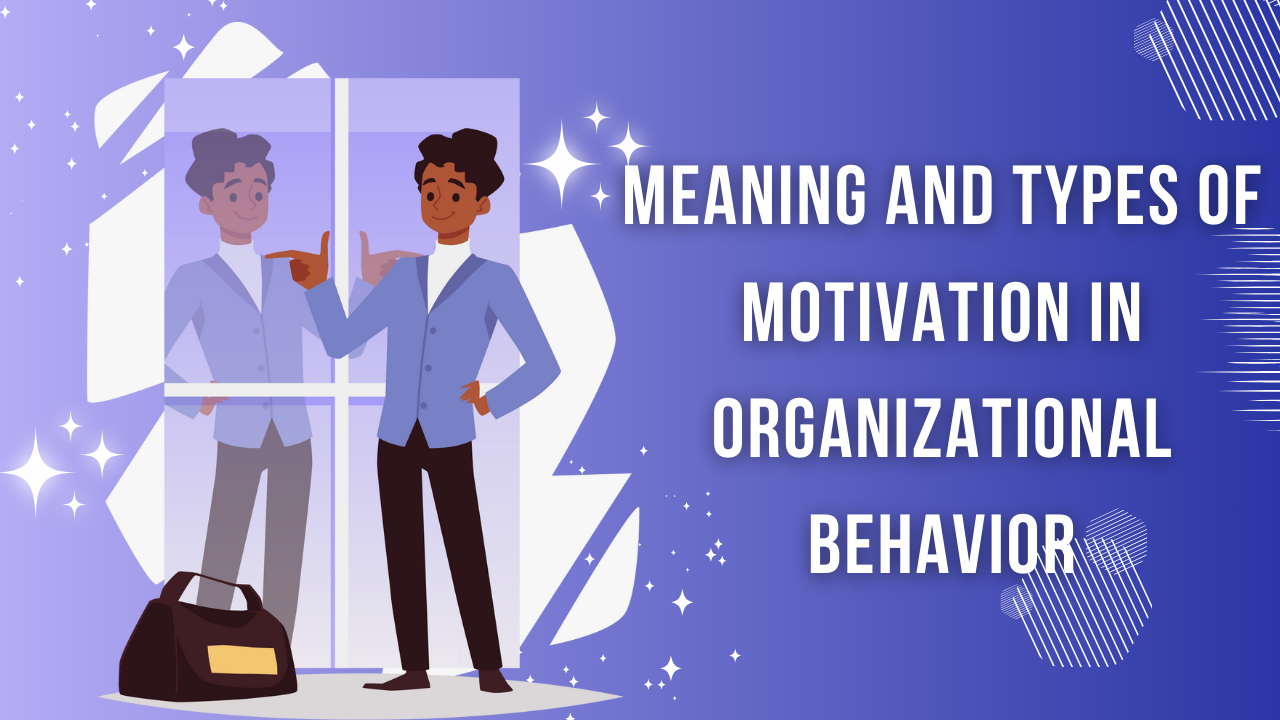Meaning and Types of Motivation in Organizational behavior
Motivation is what motivates people to take action and achieve their goals. It’s like feeling thirsty and drinking water to quench that thirst. Motivation is the desire and enthusiasm that drives a person to make a strong and persistent effort to reach their goals. It involves being interested in something and then taking steps to accomplish it. The word “motivation” comes from “motive,” which means a person’s needs, desires, wants, or urges. Motivation is what encourages people to take action to achieve something.
Table of Contents

Meaning of Motivation
Motivation is the driving force that motivates people to take action to achieve their goals. It is like being thirsty and drinking water to quench that thirst. It is the desire and enthusiasm of a person that makes a strong and persistent effort to reach desired goals. Essentially, motivation involves having an interest in and taking action to accomplish these goals.
The word “motivation” comes from the word “motive,” which refers to a person’s needs, desires, wants, or urges. It is the process that encourages people to take action to achieve something.
Examples of motivation
- Motivation to exercise: Arya wants to feel healthier and be more energetic. She is motivated to go to the gym three times a week because she knows it will help her to feel better and stay fit.
- Motivation to study: Rahul wants to get good grades so he can get into a good college. He is motivated to work hard every day because he knows it will help him achieve his goal of getting into his dream school.
- Motivation at work: Sara wants to get a promotion at her job. She is motivated to work extra hours and take on more responsibilities because she knows it will help her move up in the company.
- Motivation to save money: Rishi wants to buy a new car. He is motivated to save money by cutting down on eating out and unnecessary shopping because he knows it will help him to save enough to buy the car he wants.
- Motivation to learn a new skill: Sania loves to cook and wants to become a better chef. She is motivated to take cooking classes and practice new recipes because she enjoys cooking and wants to improve her skills.
Types of Motivation
1. Positive and Negative Motivation
a. Positive Motivation:
Positive motivation involves encouraging people by giving them rewards or benefits. It aims to make people feel good about their work, so that they are motivated to keep doing it.
Examples of Positive Motivation:
- At the workplace: Giving bonuses to employees for meeting sales targets or completing projects on time.
- At school: Awarding student’s certificates or medals for good performance.
b. Negative Motivation:
Negative motivation involves using the fear of punishment to encourage people to take action. It aims to motivate people to avoid negative consequences by doing what is expected from them.
Examples of Negative Motivation:
- At the workplace: Threatening employees with a pay cut or demotion if targets are not met. Or if an employee is often late to work, he may be warned that he may lose his job if it continues. If employee wants to avoid losing his job, he will starts arriving on time. The fear of being fired motivates him to be punctual.
- At school: Giving students detention or extra homework if they do not complete their assignments. Or if a student does not do his homework, he may be given detention. If student wants to avoid detention, he does his homework. The fear of detention motivates him to complete his work.
2. Intrinsic and Extrinsic Motivation
a. Intrinsic Motivation:
Intrinsic motivation comes from within the individual. It is motivated by personal satisfaction and the pleasure of doing something because it is interesting or enjoyable.
Examples of Intrinsic Motivation:
- Hobbies: Painting, playing a musical instrument, or writing, simply for pleasure and satisfaction.
- Learning: Learning a new language because you find it fascinating, not because you need it for a job.
b. Extrinsic Motivation:
Extrinsic motivation comes from outside the person. It is motivated by external rewards such as money, grades, or praise, or by the desire to avoid negative consequences.
Examples of Extrinsic Motivation:
- At work: Working overtime to get a promotion or bonus.
- At school: Working hard to get good grades or praise from teachers and parents.
3. Financial and Non-Financial Motivation
a. Financial Motivation:
Financial motivation involves using money and other financial incentives to motivate people. The idea is that people will work harder and be more productive if they know they will get financial rewards.
Examples of Financial Motivation:
- At work: Paying employees higher salaries, bonuses, or commissions.
- Sales: Offering discounts or cashback offers to encourage customers to make more purchases.
b. Non-financial motivation:
Non-financial motivation involves using rewards that do not involve money. These rewards can make people feel valued and appreciated, which can be a powerful motivator.
Examples of Non-financial motivation:
- At the workplace: Offering employees certificates, trophies, public recognition or professional development opportunities.
- At school: Awarding students with medals, certificates or commendations during assemblies or ceremonies.
Frequently Asked Questions (FAQ) About Motivation
What is motivation?
Why is motivation important?
What are the types of motivation?
1. Positive and negative motivation
2. Intrinsic and extrinsic motivation
3. Financial and non-financial motivation
Can you give examples of positive motivation?
What is negative motivation?
What is intrinsic motivation?
What is extrinsic motivation?
How does financial motivation work?
Can you give examples of non-financial motivation?
How can understanding motivation help achieve goals?
Conclusion of Motivation
In short, motivation is a powerful force that helps people achieve their goals. Whether it’s driven by rewards, personal satisfaction, or a desire to avoid negative consequences, understanding the different types of motivation can help us create environments where people feel motivated to take action. By identifying what motivates us and others, we can set ourselves up for success and reach the goals we want.








This blog post is a masterclass in content creation. Thanks for such well-researched material!
This blog post is a masterclass in content creation. Thanks for such well-researched material!
Your article helped me a lot, is there any more related content? Thanks!
Thank you for your shening. I am worried that I lack creative ideas. It is your enticle that makes me full of hope. Thank you. But, I have a question, can you help me?
Thank you for your sharing. I am worried that I lack creative ideas. It is your article that makes me full of hope. Thank you. But, I have a question, can you help me?